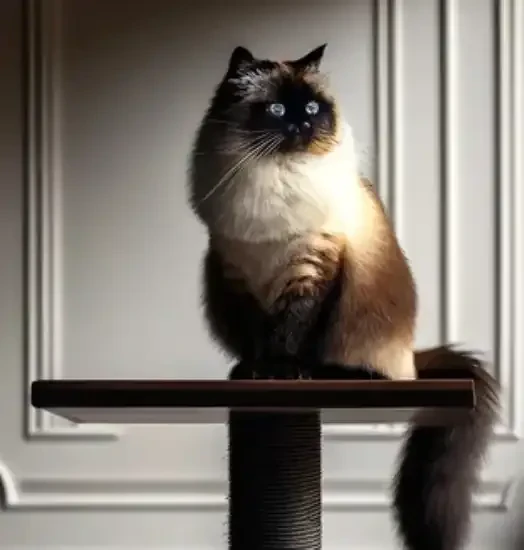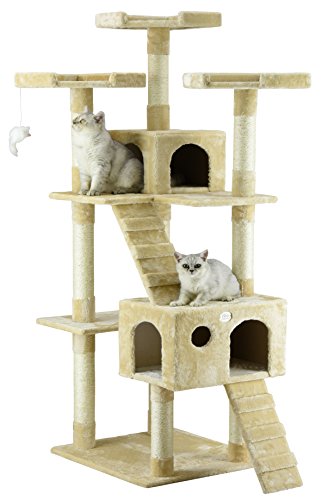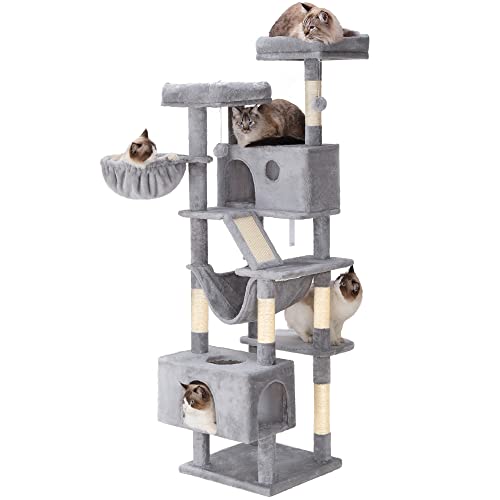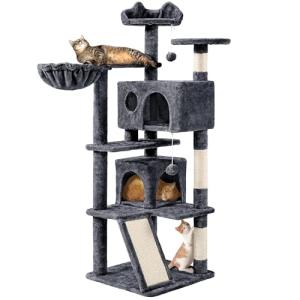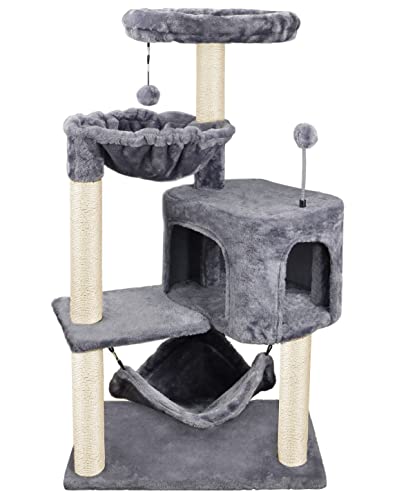Imagine your feline companion, perched gracefully on the windowsill, a silent observer of the world beyond the glass. Perhaps you've caught them gazing longingly at the fluttering leaves of a tree, or a bird flitting across the lawn. This wistful observation is a common scene in homes across the globe, homes where cats live exclusively indoors. Indoor cat ownership has become increasingly popular, and for good reason. It offers significant benefits: protection from outdoor dangers like traffic, predators, and diseases, leading to longer lifespans for our beloved pets, and a reduced impact on local wildlife populations. However, this entirely indoor existence presents a unique set of challenges, sometimes subtly suppressing a cat’s natural instincts and potentially impacting their overall well-being. While the safe confines of our homes shield them from external threats, they also limit their access to the rich sensory experiences and natural behaviors that are inherently feline. Therefore, creating a truly happy and healthy indoor life for our cats requires a mindful and deliberate approach. It’s about understanding their inherent needs and proactively enriching their environment, catering to their natural instincts, and diligently ensuring both their physical and mental well-being. This article will explore the essential strategies to unlock a fulfilling and vibrant indoor life for your feline friend.
To truly understand how to make an indoor cat happy, we first need to acknowledge the stark contrast between their domestic reality and the life their wilder ancestors – and even their outdoor roaming cousins – experience. In their natural state, cats are hunters, explorers, and territorial beings. Their days would be filled with the thrill of the chase, the mental stimulation of navigating vast territories, the physical exertion of climbing trees and traversing diverse landscapes, and the complex social interactions with a variety of creatures, both prey and rival. Confine that spirit entirely within the four walls of a home, no matter how loving, and you inherently limit these natural outlets. The indoor environment, while safe and controlled, becomes a limited stage. Sensory input can be less diverse, space is restricted, and they become entirely reliant on their human companions for every need, from food and water to entertainment and social interaction.
This confinement, if not thoughtfully managed, can lead to a cascade of potential challenges for indoor cats. Boredom and a lack of stimulation are perhaps the most insidious. Without the mental and physical challenges of the outdoors, indoor cats can easily become lethargic and disinterested. This lack of engagement can manifest in inactivity, sometimes leading to destructive behaviors as they seek to create their own entertainment, and in more severe cases, even depression. Weight gain and obesity are a very real consequence of reduced activity combined with readily available food. Without the energy expenditure of hunting and exploring, and often with access to free-feeding bowls, indoor cats are prone to packing on extra pounds, increasing their risk of diabetes, arthritis, and other weight-related health problems. Behavioral issues often stem from unmet needs. Stress, anxiety, and frustration due to boredom or lack of appropriate outlets can manifest as aggression, excessive vocalization, inappropriate scratching, or litter box avoidance. Beyond behavioral issues, physical health problems can also arise indirectly from a less stimulating indoor life. Inactivity can contribute to digestive issues and muscle weakness, while stress can weaken the immune system, making them more susceptible to illness.
It's crucial to understand that indoor cat happiness and health are not simply automatic byproducts of providing food and shelter. They require intentional effort and a proactive approach from us, their human guardians. We must actively work to bridge the gap between their natural instincts and the limitations of their indoor world. This means becoming architects of enrichment, creators of stimulating environments, and dedicated providers of both physical and mental fulfillment. Let's explore how we can transform our homes into feline paradises, ensuring our indoor cats thrive in every sense of the word.
Creating an enriching indoor environment starts with understanding how cats perceive and interact with their world. One fundamental aspect is recognizing that vertical space is absolutely key. Think of a cat's natural environment – trees, high vantage points – they instinctively seek out elevated positions to survey their surroundings, feel safe, and establish territory. Cat trees and towers become essential pieces of indoor furniture, not just decorative accessories. Look for trees that offer a variety of heights, platforms at different levels for lounging and jumping, integrated scratching surfaces to satisfy their scratching instincts, and cozy hiding spots nestled within or on top. Shelves and wall-mounted perches are another fantastic way to expand their vertical territory. Strategically placed shelves, creating a climbing pathway along a wall, or individual perches mounted near windows, allow cats to explore different levels of the room and gain a sense of dominion over their domain. Window perches are particularly valuable, acting as portals to the outside world. Providing comfortable perches near windows, especially those overlooking gardens, bird feeders, or even just street activity, offers endless entertainment and sensory stimulation as they observe the ever-changing outdoor landscape.
Scratching is not just a destructive habit for cats; it’s a deeply ingrained natural behavior essential for claw maintenance, scent marking, and stress relief. Providing scratching opportunities galore is vital for both their physical and mental well-being, and for saving your furniture! Offer a variety of scratching posts and pads in different materials. Experiment with sisal, carpet, and cardboard to discover your cat's preferences. Consider different orientations as well – vertical posts for stretching and scratching upright, horizontal pads for scratching flat, and angled scratchers for variety. Strategic placement is crucial. Place scratching posts near sleeping areas, doorways, and any furniture you notice your cat showing an interest in scratching. Make those scratching posts appealing! Sprinkle them with catnip to initially attract their attention, attach dangling toys to encourage interaction, and ensure they are sturdy and stable so they don't wobble or tip over during use, which can deter cats.
Cats, by nature, are both curious explorers and creatures who value security. Providing hiding places and safe zones addresses their innate need for privacy and retreat. Covered beds and enclosed spaces offer a sense of security and shelter. Simple cardboard boxes, fabric tunnels, cozy spaces under beds or furniture, and purpose-built cat caves all serve as valuable retreats. Quiet retreats, located away from high-traffic areas of the home, are essential for providing a sense of calm and privacy, especially in busy households or homes with other pets. Offer multiple options for hiding places throughout the home, in different rooms and at different levels, giving your cat choices and ensuring they always have a safe haven available, no matter where they are in the house.
Engaging sensory stimulation is crucial for preventing boredom and enriching an indoor cat's world. Window views are a primary source of visual stimulation. Maximize their access to windows, consider placing bird feeders or squirrel feeders outside windows to provide captivating wildlife viewing opportunities. Even just the changing light, weather, and human activity outside can be fascinating for a housebound cat. Scent enrichment can be powerful. Catnip is a classic, but explore other cat-safe herbs like silver vine or valerian. Pheromone diffusers, if appropriate for your cat's temperament and needs (consult your vet), can create a calming and comforting olfactory environment. Sound stimulation, used thoughtfully and cautiously, can also add interest. Bird sounds, nature sounds, or calming music specifically designed for cats can provide gentle auditory enrichment. However, always monitor your cat’s reaction; some cats might be sensitive to certain sounds, so use these stimuli cautiously and observe their behavior for signs of stress or anxiety. Taste and texture exploration, within safe boundaries, can also be stimulating. Growing cat grass provides a safe and palatable plant for them to nibble on. Offer a variety of textures in their food and treats, within their dietary guidelines, to keep mealtimes interesting.
Finally, no indoor cat environment is complete without toys and play for mental and physical exercise. A variety of toys is key to maintain their interest. Interactive toys, like wand toys, feather wands, and laser pointers (used responsibly – never shine directly in their eyes and always end the play session with a physical toy to "catch"), mimic the movement of prey and encourage active participation. Puzzle toys and food-dispensing toys challenge their minds as they work to extract treats, providing mental stimulation and slowing down eating. Solo toys, like balls, toy mice, and crinkle balls, provide independent entertainment when you're not available for interactive play. Rotate toys regularly to maintain novelty and prevent boredom. Keep a selection of toys available and switch them out every few days to re-spark their interest. Scheduled play sessions are non-negotiable. Dedicate specific times each day for interactive playtime, even just 10-15 minutes, to mimic hunting behavior, provide essential physical exercise, and strengthen your bond with your cat.
To further enhance their indoor lives, consider ways to bring the outdoors in, safely. Cat-safe plants, like wheatgrass, catnip, and valerian, bring a touch of nature indoors. Ensure they are non-toxic to cats and monitor your cat's interaction to prevent over-consumption or potential digestive upset. Consider a catio or safe outdoor enclosure if you have the space and resources. A secure outdoor space, whether a fully enclosed cat patio or a screened-in porch, provides access to fresh air, sunshine, and the sights and sounds of the outdoors without the dangers of roaming free. Supervised outdoor time, if safe in your environment and your cat is comfortable and amenable, can be an enriching experience for some cats. Harness and leash training, done gradually and patiently, can allow for controlled outdoor exploration. However, this requires careful consideration of your location, your cat’s temperament, and a commitment to consistent and safe training practices.
Beyond environmental enrichment, nurturing an indoor cat’s physical health requires a proactive and informed approach. Nutrition is paramount. A high-quality diet and proper nutrition are the foundation of their well-being. Choose age-appropriate, high-quality cat food. Look for recipes with a high protein content, limited fillers, and named meat sources as primary ingredients. Portion control and feeding schedules are crucial to prevent overfeeding and maintain a healthy weight. Avoid free-feeding dry food, which can contribute to weight gain. Establish regular feeding times and measure out appropriate portions according to your cat's age, activity level, and the food manufacturer's guidelines. Hydration is just as vital as food. Ensure fresh water is available at all times, in multiple locations around the house. Water fountains can encourage drinking, and consider supplementing their diet with wet food, which has a much higher moisture content than dry kibble. Avoid overfeeding treats and “human food”. Treats should be given in moderation and make up only a small percentage of their daily calorie intake. Avoid giving them table scraps or human food, which can be unhealthy or even toxic to cats.
Exercise and maintaining a healthy weight are equally crucial. Interactive play sessions are not just fun, they are essential for burning calories and keeping them physically fit. Focus on play that mimics hunting behavior: stalk, chase, pounce, catch using wand toys and feather wands. Encourage active play with toys that stimulate movement, like balls, toy mice, and puzzle feeders that require them to move around to access food. Create opportunities for movement throughout their day. Place food bowls in different locations around the house, even on different levels, encouraging them to move to eat. Encourage them to climb cat trees and shelves to reach treats or toys. Monitor their weight regularly. Learn to recognize a healthy weight for your cat and adjust food portions and activity levels as needed to prevent obesity, consulting with your veterinarian if you have concerns.
Grooming for health and well-being is not just about aesthetics; it's about maintaining their physical comfort and hygiene. Regular brushing is essential to prevent mats and hairballs, stimulate their skin, and strengthen the bond between you and your cat. Nail trimming prevents overgrowth, injury, and protects your furniture from unwanted scratching. Dental care, often overlooked, is critical for overall health. Regular veterinary dental check-ups are essential. Consider incorporating dental treats or cat-specific toothbrushes and toothpaste into their routine, as recommended by your veterinarian. Bathing should be done only as needed, as most cats are meticulous groomers. When bathing is necessary, make it a positive and low-stress experience, using cat-specific shampoos and gentle techniques.
Finally, preventative veterinary care is the cornerstone of long-term health. Regular veterinary check-ups, ideally annually or bi-annually, are vital for catching potential health issues early. Vaccinations, parasite control, and routine dental health checks are all essential components of preventative care, even for strictly indoor cats. Parasite control, including flea, tick, and worm prevention, is still important for indoor cats, as parasites can be brought into the home on shoes, clothing, or other pets. Core vaccines are recommended for all cats, regardless of lifestyle, and discuss lifestyle vaccines with your veterinarian to determine if any additional vaccinations are appropriate for your indoor cat based on their individual risk factors. Professional dental cleanings, as recommended by your veterinarian, are important for maintaining optimal oral health and preventing dental disease.
Beyond the physical, nurturing an indoor cat’s mental and emotional well-being is just as crucial for their overall happiness. Social interaction and companionship are fundamental. Quality time with humans is essential – dedicate time each day for play, petting, grooming, and simply talking to your cat. Understanding cat communication is key to responding to their needs. Learn to recognize feline body language and vocalizations to better understand their mood, needs, and preferences. Consider a companion cat, carefully and thoughtfully. For some cats, a compatible feline companion can alleviate loneliness and provide social interaction. However, this requires careful consideration of personalities and a gradual, patient introduction process to ensure a harmonious relationship.
Mental stimulation and enrichment extend beyond just toys. Puzzle feeders and food-dispensing toys challenge their minds during mealtimes, making eating a more engaging activity. Training and clicker training, surprisingly effective for cats, can provide mental engagement, strengthen your bond, and even teach them useful behaviors. Environmental variety, even subtle changes, can keep their minds engaged. Occasionally rearranging furniture, introducing new toys or scents, or rotating window perches can provide a sense of novelty and exploration within their familiar environment.
Creating a calm and stress-free environment is essential for their emotional well-being. Minimize loud noises and sudden changes, as cats thrive on routine and predictability. Provide safe and quiet retreats where they can escape from stressors, whether it’s a busy household, loud noises, or unfamiliar guests. Gradual introductions to new people, pets, and environments are crucial to avoid overwhelming them with sudden changes. Pheromone therapy, such as Feliway diffusers or sprays, can be helpful for some cats prone to anxiety, but should be used in consultation with your veterinarian.
Finally, be vigilant in recognizing and addressing behavioral issues. Learn to identify signs of stress, anxiety, and boredom, which can manifest in various ways, from hiding and overgrooming to changes in appetite or litter box habits, aggression, or excessive vocalization. For persistent or concerning behavioral issues, always consult with a veterinarian or a certified cat behaviorist. It’s crucial to rule out any underlying medical causes for behavioral changes and to develop a tailored behavior modification plan if needed.
Diligent monitoring of health and recognizing signs of illness is the final piece of the puzzle. Regularly observe your cat's behavior and habits, paying attention to any changes in appetite, water intake, litter box habits, energy levels, grooming routines, and vocalization patterns. Knowing what is “normal” for your cat is essential for identifying when something is amiss. Establish a baseline understanding of their usual behavior to quickly recognize deviations. Be aware of common signs of illness to watch for, including lethargy, changes in appetite or water intake, vomiting or diarrhea, changes in litter box habits, coughing or sneezing, changes in grooming, weight loss or gain, and changes in vocalization. Never hesitate to contact your veterinarian promptly if you notice any concerning changes in your cat’s health or behavior. Early intervention is almost always key to achieving better treatment outcomes and maintaining your cat’s well-being.
Creating a happy and healthy indoor life for your cat is a multifaceted endeavor, but undeniably a rewarding one. It requires a conscious and consistent commitment to understanding and meeting their unique needs. By prioritizing enrichment, providing proper nutrition and exercise, fostering mental stimulation, practicing preventative care, and remaining attentively observant of their health and behavior, you can transform your home into a feline haven. The effort you invest in creating this nurturing environment will be repaid tenfold in the years of companionship, affection, and joy you share with your thriving indoor feline friend. A happy and healthy indoor cat is not just a pet; they are a cherished member of the family, and providing them with the best possible life within your home is a testament to the extraordinary bond you share.
